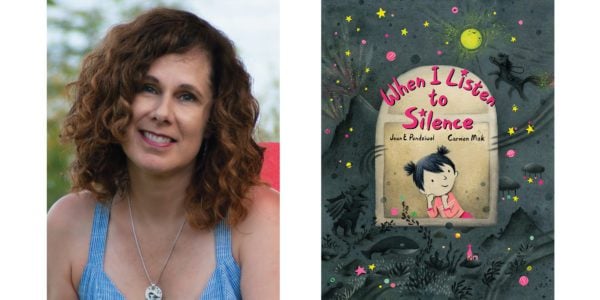
Jean E. Pendziwol (Ryan Pendziwol), When I Listen to Silence
With 10 previous picture books and an acclaimed adult novel under her belt, Jean E. Pendziwol knows a lot about imagination. She’s also keen to provide space for her young readers’ imaginations to run wild. What that space looks like, though, might be unexpected – as with Pendziwol’s dreamy new picture book, When I Listen to Silence (Groundwood Books, April).
Any caregiver will tell you that “small kids” and “silence” are not concepts that one would usually group together. But Pendziwol’s lilting, lyrical text – which opens with a mother gently asking her young child to stay quiet for a while as she works at home, a now-common scenario for parents – shows that sometimes a moment of quiet freedom can be a wonderful gift to a child’s imagination.
“We can have kids who are very overscheduled, overstimulated [these days],” Pendziwol told Quill & Quire. “I wanted to explore the idea of allowing stillness and silence – the opportunity for creativity – to have a chance to take root and to grow.” That growth unfurls spectacularly in the story. As Pendziwol says, “It’s really neat to see how noisy [the story] becomes, how much richness there is … when [a child is] given that opportunity to just be still and be quiet and let that happen.”
Indeed, the massive imaginative possibilities of silent daydreaming are put on epic display in the book, with the child narrator’s adventure swelling to include mermaids, dragons, knights, pirates, and even a trip to the moon – a kind of fabulous, imaginative maximalism.
The rhythmic, looping structure of the text adds to the organic nature of Pendziwol’s storytelling. She was inspired by a 2017 workshop led by writer Gary Barwin in which guests responded to the structure of Elizabeth Bachinsky’s poem “When I Have the Body of a Man” (from The Hottest Summer in Recorded History, Nightwood Editions).
Bachinsky’s formula of starting each line with “When” and building with a kind of cheeky creativity to the next “When” served the poet well, and Pendziwol’s adaptation of the concept is a perfect fit for When I Listen to Silence because it mimics a child’s natural, escalating storytelling excitement.
“I was playing around with that structure … a circular story … but it’s also very much how our imaginations work. We start in one place and, in just a heartbeat, it moves from one thing to the next to the next to the next, and builds on that until you have this whole complete picture.”
Illustrator Carmen Mok clearly understood how essential that looping structure was to the story, and Pendziwol is thrilled with how the artwork not only echoes but also expands on the concept. She praised her publisher’s canny matching of creators. “Groundwood Books is just so fabulous at pairing text and illustrator; they have this magic,” she says. “[Mok] brought that circular structure in with her images and [connected] each image to the next where, if you could open up the book and stretch it out in one long page, you could connect it all together. … If you look carefully from page to page, it’s really one image. … I thought it was just so brilliant how she did that.”
Pendziwol even mused that she may get creative with the structural elements of the book when reading from it. “It would be super fun to go into a classroom with kids,” she says, “and have them pull it all open … just putting it in a circle.”
Adults as well as kids will see themselves in When I Listen to Silence, especially these days. Pendziwol’s work on the book started before the pandemic, but decisions Mok made with the artwork – especially the now-familiar image of a parent working on a laptop at a kitchen table – make the book relatable for the post-2020 parent.
“I thought it was so timely and relevant, with so many parents working from home, trying to find that balance within the home environment. … It’s so interesting when you see the illustrations and say, Yes, this is the reality for a lot of people right now.” Pendziwol hopes that the story provides what so many parents have been looking for in these strange times: a way to help kids find resilience and joy. “It’s building on those natural ways that children play,” she says. “That sense of creativity, the imagination.”
The book ends by taking readers back to the beginning – with a twist – when the child, still lost in the story, asks the mother for quiet so the adventure can continue. It’s a fitting end from Pendziwol: a playful challenge to see just how high imagination can soar when given the space.
 Contact us via email
Contact us via email

